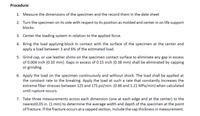
Structural Analysis
6th Edition
ISBN: 9781337630931
Author: KASSIMALI, Aslam.
Publisher: Cengage,
expand_more
expand_more
format_list_bulleted
Question

Transcribed Image Text:Procedure:
1. Measure the dimensions of the specimen and the record them in the date sheet
2. Turn the specimen on its side with respect to its position as molded and center in on life support
blocks.
3. Center the loading system in relation to the applied force.
4. Bring the load applying-block in contact with the surface of the specimen at the center and
apply a load between 3 and 6% of the estimated load.
5. Grind cap, or use leather shims on the specimen contact surface to eliminate any gap in excess
of 0.004 inch (0.10 mm). Gaps in excess of 0.15 inch (0.38 mm) shall be eliminated by capping
or grinding.
6. Apply the load on the specimen continuously and without shock. The load shall be applied at
the constant rate to the breaking. Apply the load at such a rate that constantly increases the
extreme fiber stresses between 125 and 175 psi/min. (0.86 and 1.21 MPa/min) when calculated
until rupture occurs.
7. Take three measurements across each dimension (one at each edge and at the center) to the
nearest0.05 in. (1 mm) to determine the average width and depth of the specimen at the point
of fracture. If the fracture occurs at a capped section, include the cap thickness in measurement.

Transcribed Image Text:Calculation:
For center Loading:
MR = 3PL / 2bd?
Where:
MR- modulus of rupture, psi (MPa)
P= maximum load applied as indicated by testing machine, in Ib (N)
L= span length, in inches (mm)
b= average width of specimen in inches (mm)
d= average depth of specimen, at the fracture, in inches (mm)
Note: The weight of the beam is not included in the above calculation.
Tabulated Data and Result
Sample No.
L (mm)
B (mm)
D (mm)
P (N)
MR (MPa)
1
450
150
150
23000
2
450
150
150
21000
3
450
150
150
19000
Expert Solution
This question has been solved!
Explore an expertly crafted, step-by-step solution for a thorough understanding of key concepts.
Step by stepSolved in 2 steps with 2 images

Knowledge Booster
Learn more about
Need a deep-dive on the concept behind this application? Look no further. Learn more about this topic, civil-engineering and related others by exploring similar questions and additional content below.Similar questions
- Problem 1.4. A tensile test was conducted on a mild steel bar. The following data was obtained from the test : (i) Diameter of the steel bar (ii) Gauge length of the bar (iii) Load at elastic limit (iv) Extension at a load of 150 kN. (v) Maximum load (vi) Total extension (vii) Diameter of the rod at the failure Determine : (a) the Young's modulus, = 3 cm = 20 cm = 250 kN = 0.21 mm = 380 kN = 60 mm - 2.25 cm. (c) the percentage elongation, and (b) the stress at lastic limit, (d) the percentage decrease in area.arrow_forwardA 42 meter solid shaft is under torsional loading 53 Nm. If in this application, the allowable shear stress for the material is 369 MPa. Calculate the required minimum diameter of the shaft: _____ mm ( input the value directly from your calculation before rounding it up to an engineering accepted diameter) Pay attention to units, and calculate your answer to one decimal place.arrow_forward2 please include scketcharrow_forward
- Solve it civil problemarrow_forwardA hot rolled steel tension test sample has a diameter of 6 mm and the original gage length of 30 mm. In a test to fracture, the stress and strain data below were obtained. Determine Generic Strain Value, %0.2 offset strain, and Calculated stress at %0.2 offset. Original diameter - 6mm Original Length - 30 mm Fracture diameter - 4.54 mmarrow_forwardYou must have to draw FBDarrow_forward
arrow_back_ios
arrow_forward_ios
Recommended textbooks for you

 Structural Analysis (10th Edition)Civil EngineeringISBN:9780134610672Author:Russell C. HibbelerPublisher:PEARSON
Structural Analysis (10th Edition)Civil EngineeringISBN:9780134610672Author:Russell C. HibbelerPublisher:PEARSON Principles of Foundation Engineering (MindTap Cou...Civil EngineeringISBN:9781337705028Author:Braja M. Das, Nagaratnam SivakuganPublisher:Cengage Learning
Principles of Foundation Engineering (MindTap Cou...Civil EngineeringISBN:9781337705028Author:Braja M. Das, Nagaratnam SivakuganPublisher:Cengage Learning Fundamentals of Structural AnalysisCivil EngineeringISBN:9780073398006Author:Kenneth M. Leet Emeritus, Chia-Ming Uang, Joel LanningPublisher:McGraw-Hill Education
Fundamentals of Structural AnalysisCivil EngineeringISBN:9780073398006Author:Kenneth M. Leet Emeritus, Chia-Ming Uang, Joel LanningPublisher:McGraw-Hill Education
 Traffic and Highway EngineeringCivil EngineeringISBN:9781305156241Author:Garber, Nicholas J.Publisher:Cengage Learning
Traffic and Highway EngineeringCivil EngineeringISBN:9781305156241Author:Garber, Nicholas J.Publisher:Cengage Learning


Structural Analysis (10th Edition)
Civil Engineering
ISBN:9780134610672
Author:Russell C. Hibbeler
Publisher:PEARSON

Principles of Foundation Engineering (MindTap Cou...
Civil Engineering
ISBN:9781337705028
Author:Braja M. Das, Nagaratnam Sivakugan
Publisher:Cengage Learning

Fundamentals of Structural Analysis
Civil Engineering
ISBN:9780073398006
Author:Kenneth M. Leet Emeritus, Chia-Ming Uang, Joel Lanning
Publisher:McGraw-Hill Education


Traffic and Highway Engineering
Civil Engineering
ISBN:9781305156241
Author:Garber, Nicholas J.
Publisher:Cengage Learning